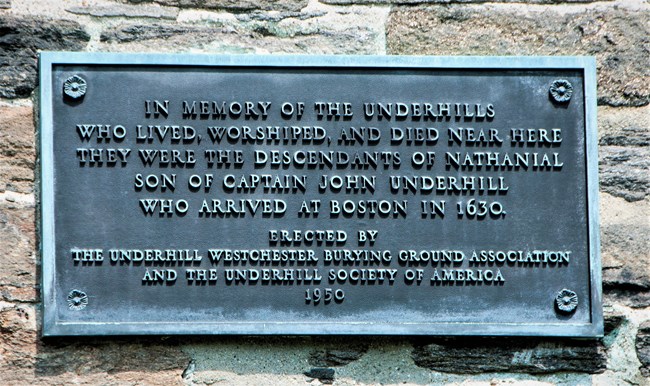Last updated: January 13, 2022
Article
Plaque at St. Paul's Recalls the Underhills: A prominent & historic local family

NPS
Bronze Plaque Honors Underhill Family at St. Paul’s
The smallest plaque on the exterior of the historic church recognizes a prominent local family and also reflects an understanding of St. Paul’s as a broader historical monument. Installed in 1950, the rectangular tablet commemorates the Underhill family, whose heritage in America dates to 1630.
The bronze plaque memorializes a long connection between the Underhill family and the parish of St. Paul’s reaching back to the 18th century. Underhill family members lived in Westchester County within a few miles of the church. Some family members worshipped here in the late 18th century, including Israel Underhill, a militia officer in the Revolutionary War. He was one of two Underhills who were original pew holders in 1787. The 19th century interment in the cemetery of more than a dozen Underhills furthered the connection between the church and the family. In the early 20th century, several historic sandstone Underhill grave markers were actually transported to St. Paul’s from a family graveyard situated three miles away in the northern Bronx because urban development required the elimination of that colonial era cemetery. The text of the plaque references that Underhill Westchester burying ground.
These circumstances illustrate a clear connection with St. Paul’s. Yet, the association is not as significant as other families who founded the church and helped develop the parish in the 18th and 19th centuries. Church and local histories clearly establish that Wards, Fowlers, Morgans, and Pickneys recorded equal or greater contributions to the growth of St. Paul’s, even though the Underhills are the only family whose ties are recognized through a permanent tablet.
The likely explanation for this apparent discrepancy involves the achievements of the Underhills in preserving their heritage through the Underhill Family Society of America, which was founded in Brooklyn in 1892. It still exists. Publications, genealogies, meetings and other activities have perpetuated the legacy of the extended family. The society’s accomplishments have included erecting many tablets and memorials that record the history of the Underhill family, including the small plaque bolted into the masonry at St. Paul’s.
A leading figure in these heritage preservation initiatives was Myron Taylor, descended on his mother’s side from early Underhill settlers in America. An industrialist and diplomat, Taylor directed the association’s activities in the mid-20th century, engineering a resurgence of the group after World War II. He was the society’s chief officer in 1950 when the small plaque was affixed near the western exterior entrance to the edifice, demonstrating the value of connecting a family’s history and role in America with a church that several years earlier had received designation as a National Historic Site.
Another possible explanation for the installation of the tablet involves the departure in 1949 of Rev. Harold Weigle as the St. Paul’s rector. Father Weigle was to a large degree the developer of St. Paul’s as a modern historic shrine, guiding the restoration of the interior to the original 1787 appearance and heralding the church’s association with important events in early American history. But as an ardent spokesman of St. Paul’s connection to events of great national significance, he would likely have objected to use of the edifice as a board for recalling one particular family. The timing of the installation of the plaque a year after Rev. Weigle’s resignation may not be a coincidence.
The text of the tablet acknowledges Captain John Underhill as the founder of the family’s legacy in America, arriving in Boston in 1630. Captain Underhill was an important yet controversial religious, political and military leader in 17th century America. He joined a group of dissenters in opposing Puritan orthodoxy in Boston and was banished from Massachusetts Bay in 1638 along with the famous religious rebel Anne Hutchinson. Underhill later served as Governor of New Hampshire.
But he is perhaps best known to history as a general of colonial militia in punitive campaigns against Indians in the Pequot War in Massachusetts in 1636 and against the Lenape in New Netherland in Keift’s War in the 1640s. Of local significance, Captain Underhill was in charge of Dutch forces that killed hundreds of Lenape in 1644 at a winter home of the Indians about 30 miles from St. Paul’s. His son Nathaniel, who is also referenced on the tablet, was the first Underhill to settle in Westchester County, beginning the family’s residence in the St. Paul’s vicinity.
